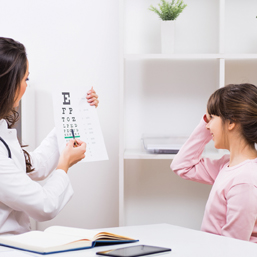
We chatted with Dr. Kim Bugera, Edmonton optometrist and Chair of the Children’s Vision Committee at the Alberta Association of Optometrists, about the things doctors of optometry see most often when performing children’s eye exams. Here’s what you need to know.
1. 80 percent of learning is visual, so if your child has an undiagnosed vision or eye health issue, they will be starting their educational journey with a deficit. Kids are great at improvising, which is what they often do when there is a vision problem. Their undiagnosed vision or eye health issues may only become apparent when they enter school and improvising no longer works because of the amount of close and distance work they must complete during school.
2. Children with vision problems are often misdiagnosed as having a learning or behavioral disability. Dr. Bugera has spoken with many parents who have spent a lot of time and money trying to correct what was thought to be a learning issue when, in fact, the child couldn’t see properly.
3. Vision screening isn’t a full exam and will only check your child’s distance acuity. More than 43 percent of children who have a vision or eye health problem can pass a basic vision screening or sight test. As an example, it won’t catch issues associated with important skills, such as color and depth perception. Not being able to correctly identify colors can impact learning, and depth perception plays a role in success at school and at play.
Imagine the frustration in playing sports and continually missing the ball. It could all relate to depth perception. Dr. Bugera also cautions parents to remember to purchase the correct protective eyewear for the sport!
4. Too often when asked to cover one eye and read the chart, the child will tell Dr. Bugera they can’t because that would mean reading with their “bad eye.” Parents are very surprised because they had no idea. Issues are often difficult to detect without an eye exam because the problem might only be in one eye. The eyes may not be working correctly together or there could be an eye health problem in one eye. Many of these problems can only successfully be treated prior to reaching eight to 10 years old.
5. Take a break from the screen. Dr. Bugera says the link is clear between too much screen time and vision and health issues. That includes everything from trouble sleeping at night to a sharp increase in myopia (nearsightedness). Her advice is to head outside and enjoy some family time together. Research shows children who spend time outdoors are less likely to develop myopia.
6. If you head outdoors, remember your sunglasses. You’re never too young for sunglasses! Just as you protect your children’s skin with sunscreen, protect their eyes. Dr. Bugera advises 100 percent UV protection year-round, so look for full protection when purchasing a pair of sunglasses. In addition to sun burning the eyes, infants and young children are especially vulnerable to UV radiation which is absorbed by the tissue of the eye and can cause serious eye damage. Exposure to UV is cumulative, so direct contact with sunlight for even short periods of time can cause several long-term eye health problems.
Following some simple guidelines and ensuring your child has their annual comprehensive eye exam with an optometrist can help ensure they have a lifetime with healthy eyes and the best vision possible. Remember, children’s eye exams are covered by Alberta Health until the child turns 19. A child’s first eye exam should take place between six and 12 months. To learn more about children’s eye health, visit optometrists.ab.ca.
Calgary’s Child Magazine © 2024 Calgary’s Child